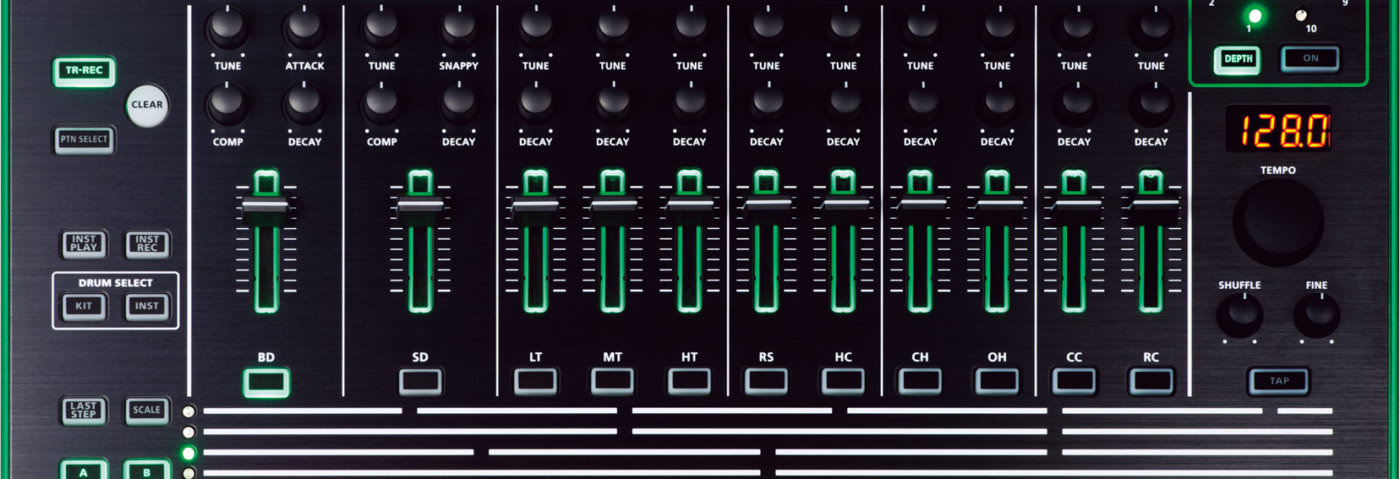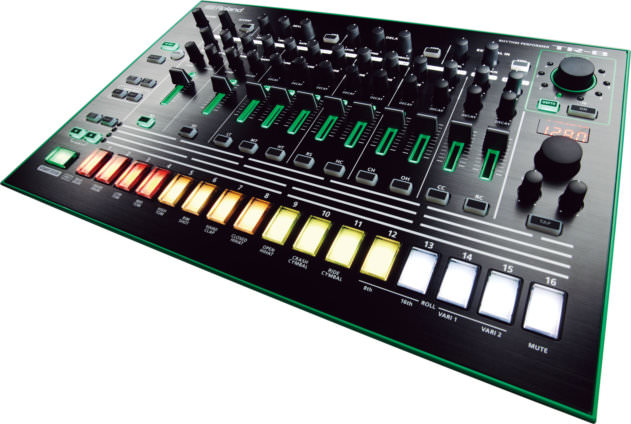Sequencer
It may seem odd given the focus on recreating the sounds of two iconic instruments, but to me the best feature of the TR-8 is the sequencer. You can get pretty close to authentic 808 and 909 sounds using samples or plugins, but what you don’t get from that approach is the same kind of hands-on appeal you’d find in the 808 or 909 (which had subtly different variations on Roland’s TR-x0x step sequencer setup).
The approach is familiar by now (not least because so many drum machines have adopted it from Roland over the last few decades). The 16 buttons across the bottom of the unit appear to be borrowed from the Jupiter 80; the red-orange-yellow-white colour scheme immediately harks back to the 808 and it’s reflected in the step sequencing approach.
In addition to the basic real-time or step-time recording options, the TR-8 adopts some of the best features of the other TR sequencers: A and B part variations like the 808, ‘shuffle’ (swing) control like the 909, and individual faders for each drum channel like the 707. The result is a very versatile setup which is particularly well suited to live performance and real-time manipulation.
Individual channels can be muted in Instrument Play mode, which also allows drums to be triggered using a choice of four roll options: 8th-note, 16th-note, Vari 1 and Vari 2. You won’t find a song mode for creating entire arrangements from a string of patterns, but you can copy patterns between slots to build variations and trigger them manually in Pattern Select mode. Overall it’s one of the best drum sequencers Roland have ever built.
It's one of the best drum sequencers Roland have ever built
Modern twist
The TR-8 doesn’t just look to the past. There are a number of areas where Roland have made significant efforts to modernise the feature set, bringing the TR concept right up to date. The most obvious is the inclusion of dedicated compression controls for the kick and snare channels. These are digital effects, controlled by a single knob and designed to add a vintage compression character. They work incredibly well, giving real versatility to both sounds. Given how well the 808 and 909 kicks and snares respond to compression, it’s an excellent addition to the unit.
The effects don’t stop there. Along the top of the unit you’ll also find separate reverb and delay options, plus a Scatter effect. These are a little more heavy-handed than the compression circuits – the reverb and delay can both be assigned on a per-step basis, while the Scatter function offers all manner of glitchy stutter and reverse effects. They won’t be to everyone’s taste, but they’re an interesting option.
The dedicated compression controls for the kick and snare work incredibly well.
The TR-8’s MIDI spec is comprehensive, while the connectivity options are modernised in an interesting way. The TR-8 only features a pair of master outputs and two assignable outputs, but the AIRA units’ implementation of audio over USB is excellent. Install the TR-8 driver and the individual channel outputs can be recorded into your DAW without ever leaving the digital domain. (Note that, unlike the other AIRA units, the TR-8 requires too much power to run from the USB bus, so you’ll still need the external power supply connected to use it over a USB connection.)
Conclusion
It’s probably inevitable that the hardcore purists will dismiss the TR-8 on the grounds that it’s not the exact analogue clone they were hoping for. They’d be missing out by doing so. Aside from the fact that it’s highly unlikely Roland could produce a true analogue 808 or 909 clone at this affordable price point, if you want the real thing, the only option which will truly satisfy you is to save up and buy a second-hand original.
But the TR-8 isn’t competing with the TR-808 or 909. It’s not even competing against hardware 808 and 909 clones or expensive analogue drum machines like the DSI Tempest or Elektron Analog Rytm. Instead, judge it against other options in a similar class. It’s more versatile than even the most comprehensive sample pack.
It’s got the hands-on appeal which even the best plugins like Nepheton and Drumazon can’t come close to without spending hours mapping a hardware controller to every last function and parameter. It’s significantly more expensive than the Korg Volca Beats – an inevitable comparison – but it’s also a huge step up in terms of build quality, functionality and versatility.
The TR-8 stays true to the most important characteristics of the classic TR-x0x drum machines: immediacy, hands-on control and excellent sound.
The Verdict
Price: £399
Purchase: Roland AIRA TR-8
The Final Word
The spirit of the classic TR series reborn for the 21st century


04.08 PM
any idea if the sequencer can be used to sequence other midi gear ?
in my case it would be interesting to know if you can hook up my MFB 522 to the Midi Out of the TR-8 and use the big&full 16 steps to sequence the mfb ?!
i could then bring the 522´s stereo out back into the TR-8´s ext. input…
is there any info out there what midi data the TR-8´s stepseq runs out of the midi out ? 🙂
04.23 PM
Nick – from what I hear the TR8 sends MIDI out over USB and DIN in all edit/playback modes. Ironically, I’ve been looking for a sequencer exactly like this (basically a 707 sequencer which sends MIDI in edit mode) to sequence my Drum Station, which it looks like the TR8 just made redundant.
The TR8 looks pretty good but I wish they included a few other sounds. From what I’ve seen in demos, there doesn’t seem to be any reason not to have up to 16 different sounds available for each drum slot. Even without modelling the other analogue units like the 606 and CR78 I don’t see why they couldn’t have included samples of the digital units like the 707 and R8. That would make it a no-brainer to me. As it stands I’ll probably get one eventually but I’m happy to wait a while and see if the price comes down or if they keep developing it with firmware updates.
That thing about having to choose between certain sounds looks annoying too. It would be cool if you could have both kick drums at once, or even have two copies of the same kick to tune and process differently. Seeing as it’s digital why limit it like that?
03.05 PM
Thanks for the feedback ! 🙂
according to this guy @ 1:20min the next addition will be TR-707 via firmware.
https://www.youtube.com/watch?v=_6Ob-pp3jAc
i think i might just wait for Akai´s rythm wolf for the sequencer – Tr-8 is looking good but i am not sure if its the unit to go for right now for my purposes.
05.03 PM
TR-707 update is a waste of time. They should first add the TR-727, TR-606, and CR80. I would hope they add fresh sounds never made available to the TR series, but we can always do without it.
04.49 AM
If interested, I did a review here, which focuses on the stuff most other reviews did not touch on. Just opinions, but worth reading before buying one.
http://bitterharvest.ca/roland-aira-tr-8-review-the-stuff-no-one-else-told-you/
03.42 PM
@ S. Righteous
thanks for this interesting review – i have one question, which would also answer my initial question here in the comments.
What kind of midi is the TR-8 sending out, i.e. what notes do get recordet in your daw for the indiviual sounds. simple Midi note values ?
feedback would be awesome 🙂
09.59 PM
@ Nick Shepard
Note values, note length being 16th notes (or 32nd, or 8th/16th trip based on the “Scale” button). The Knobs and faders are automatable inside a DAW as well.
02.20 PM
cool – thanks for your feedback !
04.21 PM
The TR-8 is really great, just hope Roland will touch up some aspects of the emulation in a future update; the 909 snare + clap artifact needs some work as does the 808 bass drum accent and pitch variation that occurs at certain decay settings. I’d say that would take the TR-8 from 85% there to 95% there.
ACB seems more than just marketing, now just keep supporting and improving on it Roland.
10.01 PM
Well I’ve got a Tr8 and have to say that the machine is very inspiring. It hands down beats any software simulation and just by the sheer nature of being able to tweak every thing live you end up with beats and grooves and sounds that you just wouldn’t get sitting in front of your computer screen using a mouse. The scatter function has some really interesting sounds. I stumbled upon a bit crushing effect which makes the beats really dirty! The ACB technology is very nice too as the effects have very subtle variations which really breathe life into things. Above all, the machine puts the fun back into the studio. I have all my synths and sampler hooked up to ableton so it can all be played live. Just hit record and jam the night away. Ideas creation heaven!
12.14 PM
tr-8 is not bad…
Though snares and claps sux compared to the real deal.
909 closed hit hat also doesn’t sound right.
But it’s by far the best clone ever made.
Hope a future update to solve those problems.
I ll keep the real deal for now !
07.35 AM
The analogue behaviour is not prominent enough on the 909 and especially the 808 kicks.
Hoping for an update to fix these issues as well.
03.31 PM
We grabbed one of these as a secondary drum machine for live use (primary machine being Livid Cntrlr running Steppr). Our thoughts so far:
Good:
– sounds, sequencing, swing
– midi sync (from Live as a master) works no prob
– the delay has some cool settings when used lightly
– audio over USB worked no problem (have only tested in Windows so far)
– very fun to play using the faders
– no screen/menu + dedicated knobs per sound make for an immediate experience
– since this is a live machine for us, we don’t need a lot of storage space for patterns
– will be great if they actually release other kits, but can’t count on this til it happens!
Not so good:
– wish some of the sounds changed more across the knobs, they are not equally expressive
– the sounds could be better normalized
– scatter doesn’t add too much (sounds very glitchy so it depends on your style)
– wish you could reduce the brightness of the LEDs
– mute is a bit clunky to access, much quicker to just use the faders
– it really needs to be updated to copy between A + B patterns
– fills could be better (and should be quantized; as is, they start when you hit the fill button, which could between 16ths)
All that said, we’re happy to have it in our live arsenal, and think if Roland does come through with adding other kits it will start to approach the flexibility of other machines out there (even if only as a go to x0x machine).
04.58 PM
Can anybody make the comparison to the Native Instruments Maschine MKI sampled Roland kits (the 808 and 909 for example)… is the TR-8 superior in terms of quality.. or do you think they are both equally because it are both just digital samples… I know the Native Instruments MKI is more versatile here, but I’m really wondering which device will really deliver in terms of quality of samples for studio use. Thanks!